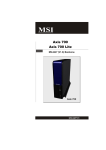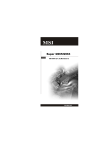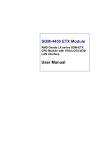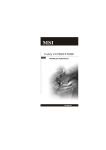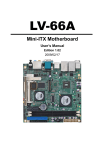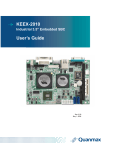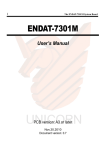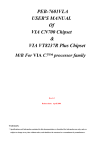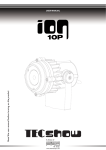Download MSI MS-7199 User`s manual
Transcript
Fuzzy CN700G Series MS-7199(V2.X) Mainboard G52-71991X2 i Copyright Notice Th e material in this d ocument is the in tellectual p rop erty of MICRO-STAR INTERNATIONAL. We take every care in the preparation of this document, but no guarantee is given as to the correctness of its contents. Our products are under continual improvement and we reserve the right to make changes without notice. Trademarks All trademarks are the properties of their respective owners. NVIDIA, the NVIDIA logo, DualNet, and nForce are registered trademarks or trademarks of NVIDIA Corporation in the United States and/or other countries. AMD, Athlon™, Athlon™ XP, Thoroughbred™, and Duron™ are registered trademarks of AMD Corporation. Intel® and Pentium® are registered trademarks of Intel Corporation. PS/2 and OS ®/2 are registered trademarks of International Business Machines Corporation. Windows® 95/98/2000/NT/XP are registered trademarks of Microsoft Corporation. Netware® is a registered trademark of Novell, Inc. Award® is a registered trademark of Phoenix Technologies Ltd. AMI® is a registered trademark of American Megatrends Inc. Revision History Revision V2.0 Revision History First release Date June 2007 Technical Support If a problem arises with your system and no solution can be obtained from the user’s manual, please contact your place of purchase or local distributor. Alternatively, please try the following help resources for further guidance. Visit the MSI website for FAQ, technical guide, BIOS updates, driver updates, an d oth er in forma tion : htt p:// glob al.m si.com.tw /ind ex.p hp? func=faqIndex Contact our technical staff at: http://support.msi.com.tw ii Safety Instructions 1. Always read the safety instructions carefully. 2. Keep this User’s Manual for future reference. 3. 4. Keep this equipment away from humidity. Lay this equipment on a reliable flat surface before setting it up. 5. The openings on the enclosure are for air convection hence protects the equipment from overheating. DO NOT COVER THE OPENINGS. 6. Make sure the voltage of the power source and adjust properly 110/220V before connecting the equipment to the power inlet. 7. Place the power cord such a way that people can not step on it. Do not place anything over the power cord. 8. Always Unplug the Power Cord before inserting any add-on card or module. 9. All cautions and warnings on the equipment should be noted. 10. Never pour any liquid into the opening that could damage or cause electrical shock. 11. If any of the following situations arises, get the equipment checked by service personnel: † The power cord or plug is damaged. † Liquid has penetrated into the equipment. † The equipment has been exposed to moisture. † The equipment does not work well or you can not get it work according to User’s Manual. † The equipment has dropped and damaged. † The equipment has obvious sign of breakage. 12. DO NOT LEAVE THIS EQUIPMENT IN AN ENVIRONMENT UNCONDITIONED, STORAGE TEMPERATURE ABOVE 600 C (1400F), IT MAY DAMAGE THE EQUIPMENT. CAUTION: Dan g er of exp losion if b attery is in correctl y rep laced . Replace on ly with the same or equivalent type recommen ded by the manufacturer. iii FCC-B Radio Frequency Interference Statement This eq uip men t h as b een tested and found to comply with the limits for a Class B digital device, pursuant to Part 15 of the FCC Rules. These limits are designed to provide reasonable protection against harmful interference in a residential installation. This equipment generates, uses and can radiate radio frequency energy and, if not installed and used in accordance with the instructions, may cause harmful interference to radio communications. However, there is no guarantee that interference will not occur in a particular installation. If this equipment does cause harmful interference to radio or television reception, which can be determined by turning the equipment off and on, the user is encouraged to try to correct the interference by one or more of the measures listed bel ow. † Reorient or relocate the receiving antenna. † Increase the separation between the equipment and receiver. † Connect the equipment into an outlet on a circuit different from that to which the receiver is connected. † Consult the dealer or an experienced radio/television technician for help. Notice 1 The changes or modifications not expressly approved by the party responsible for compliance could void the user’s authority to operate the equipment. Notice 2 Shielded interface cables and A.C. power cord, if any, must be used in order to comply with the emission limits. VOIR LA NOTICE D’INSTALLATION AVANT DE RACCORDER AU RESEAU. Micro-Star International MS-7199 This device complies with Part 15 of the FCC Rules. Operation is subject to the following two conditions: (1) this device may not cause harmful interference, and (2) this device must accept any interference received, including interference that may cause undesired operation. iv WEEE (Waste Electrical and Electronic Equipment) Statement v vi vii CONTENTS Copyright Notice ................................................................................................ ii Tr ademar ks ........................................................................................................ ii Revision History ................................................................................................ ii Technical Support .............................................................................................. ii Safety Instructions ........................................................................................... iii FCC-B Radio Frequency Interference Statement ......................................... iv WEEE (Waste Electrical and Electronic Equipment) Statement ..................... v Chapter 1. Getting Started ............................................................................. 1-1 Mainboard Specifications ............................................................................. 1-2 Mainboard Layout ........................................................................................ 1-4 Packing Checklist ......................................................................................... 1-5 Chapter 2. Hardware Setup ............................................................................ 2-1 Quick Components Guide ............................................................................. 2-2 Memory ....................................................................................................... 2-3 Power Supply .............................................................................................. 2-4 Back Panel ................................................................................................... 2-5 Connectors .................................................................................................. 2-7 Jumpers ..................................................................................................... 2-12 Slots .......................................................................................................... 2-13 viii Getting Started Chapter 1 Getting Started Thank you for choosing the Fuzzy CN700G Series (MS-7199) V2.X Min i-ITX main board. The Fuzzy CN700G Series mainboard is based on VIA® CN700 and VT8237R+ chipsets for optimal system efficiency. The Fuzzy CN700G Series mainboard delivers a high p erforman ce an d profession al desktop pl atform solution. 1-1 MS-7199 Mainboard Mainboard Specifications Processor Support - VIA ® C7 1/ 1.5/ 2.0 GHz/ 21x21mm nano BGA2 package TDP max 1GHz@9W/ 1.5GHz@12W/ 2.0GHz@20W Supports VRM mobile (down to 0.7V) Thermal design margin up to 100c Tcase 3D instructions SSE/ SSE2/ SSE3 Security Features RGN/ AES/ SHA-1 Supported FSB - 400/ 800 MHz for 1.0/ 1.5/ 2.0 GHz Chipset - North Bridge: VIA ® CN700 chipset - South Bridge: VIA ® VT8237R+ chipset Memory Support - Supports DDR2 400/ 533 SDRAM (non-ECC 533) (1GB Max) - 1 DDR2 DIMM (240-pin/ 1.8V) LAN - Supports PCI LAN 1Gb Fast Ethernet by VIA ® RTL8110SC Audio - Chip integrated by VIA ® VT1618G - Flexible 8-channel audio with jack sensing - Compliant with AC97 2.3 spec IDE - 1 IDE port by VT8237R+ - Supports Ultra DMA 66/ 100/ 133 mode - Supports PIO, Bus Master operation mode SATA - Supports two SATA ports by VT8237R+ - Supports storage and data transfers up to 150MB/s RAID - SATA1~2 supports RAID 0/ 1/ 0+1 or JBOD mode by VT8237R+ - Updated option ROM to support RAID 1-2 PDF created with pdfFactory Pro trial version www.pdffactory.com Getting Started Connectors Back Panel - 1 PS/2 mouse port - 1 PS/2 keyboard port - 2 serial ports (COMA and COMB) - 2 USB 2.0 ports - 1 LAN jack - 3 flexible audio jacks - 1 S-video port - 1 DVI port - 1 VGA port On-Board Pinheaders - 3 USB 2.0 pinheaders (6 ports) - 1 audio pinheader - 1 CD-In connector - 1 Chassis Intrusion Switch pinheader Slots - 1 PCI slot - Supports 3.3V/ 5V PCI bus Interface Form Factor - Mini-ITX (17 cm X 17 cm) Mounting - 4 mounting ho les 1-3 MS-7199 Mainboard Mainboard Layout ATXPWR Top : mouse Bottom:KB VIA C7 CPUFAN Top : VGA Port Bottom: DVI Port VIA CN700 DIMM1 VIA VT1622A Top: LAN Jack Bottom: USB ports RTL8110SC J5 Top : COMA Bottom: COMB JCI1 F_AUDIO T:Line-In M:Line-Out B:Mic CD_IN J4 BIOS VIA VT1618 VIA VT8237R Plus J3 IDE1 S-Video Out VIA VT1632A JBAT1 SATA1 SATA2 BATT + J9 JFP2 PCI 1 Fuzzy CN700G Series (MS-7199) V2.X Mini-ITX Mainboard 1-4 JFP1 Getting Started Packing Checklist MSI mainboard Power Cable MSI Driver/Utility CD SATA Cable Standard Cable for IDE Devices User’s Guide * This picture is for reference only. Your packing contents may vary depending on the model you purchased. 1-5 Hardware Setup Chapter 2 Hardware Setup This chapter provides you with the information about hardware setup procedures. While doing the installation, be careful in holding the components and follow the installation procedures. For some components, if you install in the wrong orientation, the components will not work properly. Use a grounded wrist strap before handling computer comp onen ts. Static el ectricity may damag e th e components. 2-1 MS-7199 Mainboard Quick Components Guide ATXPWR, p.2-4 CPUFAN, p.2-9 DDR2 DIMM, p.2-3 Back Panel, p.2-5 J3/J4/J5, p.2-11 IDE1, p.2-7 SATA1~2, p.2-8 F_AUDIO, p.2-9 PCI Slot, p.2-13 JFP2, p.2-10 JCI1, p.2-10 CD_IN, p.2-9 2-2 J9, p.2-11 JBAT1, p.2-12 JFP1, p.2-10 Hardware Setup Memory This DIMM slot is used for installing memory modules. DDR2 240-pin, 1.8V 56x2=112 pin 64x2=128 pin Installing Memory Modules 1. The memory module has only one notch on the center and will only fit in the right orientation. 2. Insert the memory module vertically into the DIMM slot. Then push it in until the golden finger on the memory module is deeply inserted in the DIMM slot. Important You can barely see the golden finger if the memory module is properly inserted in the DIMM slot. 3. The plastic clip at each side of the DIMM slot will automatically close. Volt Notch 2-3 MS-7199 Mainboard Power Supply ATX 20-Pin Power Connector: ATXPWR This connector allows you to connect to an ATX power supply. ATXPWR Pin Definition 20 11 1 10 ATXPWR 2-4 PIN SIGNAL PIN SIGNAL 1 2 3 4 5 6 7 8 9 3.3V 3.3V GND 5V GND 5V GND PW_OK 5V_SB 10 12V 11 12 13 14 15 16 17 18 19 20 3.3V -12V GND PS_ON GND GND GND -5V 5V 5V Hardware Setup Back Panel VGA Port LAN M ouse L-In S-Video L-Out Mic Keyboard DVI Port USB Ports Serial Ports Mouse/Keyboard The standard PS/2® mouse/keyboard DIN connector is for a PS/2® mouse/keyboard. VGA Port The DB15-pin female connector is provided for monitor. DVI Port The DVI (Digital Visual Interface) connector allows you to connect a LCD monitor. It provides a high-speed digital interconnection between the computer and its display device. To connect an LCD monitor, simply plug your monitor cable into the DVI connector, and make sure that the other end of the cable is properly connected to your monitor (refer to your monitor manual for more information.) S-Video Connector The S-Video connector allows users to connect display devices for component video output. S-Video (Super-Video, sometimes referred to as Y/C Video, or component video) is a video signal transmission in which the luminance signal and the chrominance signal are transmitted separately to achieve superior picture clarity. The luminance signal (Y) carries brightness information, which defines the black and white portion, and the chrominance signal (C) carries color information, which defines hue and saturation. An S-Video connection brings better video quality than a composite/RCA connection. USB Port The USB (Universal Serial Bus) port is for attaching USB devices such as keyboard, mouse, or other USB-compatible devices. Serial Port The serial port is a 16550A high speed communications port that sends/ receives 16 bytes FIFOs. You can attach a serial mouse or other serial devices directly to the connector. 2-5 MS-7199 Mainboard LAN The standard RJ-45 LAN jack is for connection to the Local Area Network (LAN). You can connect a network cable to it. Activity Indicator B Type No 100M Cable Plug-in Transmission Transition No 1000M Cable Plug-in Transmission Transition Link Indicator Left LED Right LED Green Lighting Green Lighting Green Blinking Green Lighting Green Lighting Yellow Lighting Green Blinking Yellow Lighting Audio Ports These audio connectors are used for audio devices. You can differentiate the color of the audio jacks for different audio sound effects. Line-In (Blue) - Line In, is used for external CD player, tapeplayer or other audio devices. Line-Out (Green) - Line Out, is a connector for speakers or headphones. Mic (Pink) - Mic, is a connector for microphones. 2-6 Hardware Setup Connectors IDE Connector: IDE1 This connector supports IDE hard disk drives, optical disk drives and other IDE devices. IDE1 Important If you install two IDE devices on the same cable, you must configure the drives separately to master / slave mode by setting jumpers. Refer to IDE devi ce’s documentation suppl i ed by the vendors for jumper setting instructions. 2-7 MS-7199 Mainboard Serial ATA Connector: SATA1~SATA2 These connectors are high-speed Serial ATA interface ports. Each connector can connect to one Serial ATA device. 7 7 1 1 SATA1 SATA2 Important Please do not fold the Serial ATA cable into 90-degree angle. Otherwise, data loss may occur during transmission. 2-8 Hardware Setup Fan Power Connector: CPUFAN GND POWER_OUT +1 2V The fan power connector supports system cooling fan with +12V. When connecting the wire to the connector, always note that the red wire is the positive and should be connected to the +12V, the black wire is Ground and should be connected to GND. CPUFAN CD-In Connector: CD_IN CD_IN This connector is provided for CD-ROM audio. R GND L Front Panel Audio Connector: F_AUDIO This connector allows you to connect the front panel audio and is compliant with Intel® Front Panel I/O Connectivity Design Guide. 10 9 2 1 F_AUDIO Pin Definition PIN SIGNAL DESCRIPTION 1 2 3 4 5 6 7 8 9 10 AUD_MIC AUD_GND AUD_MIC_BIAS AUD_VCC AUD_FPOUT_R AUD_RET_R HP_ON KEY AUD_FPOUT_L AUD_RET_L Front panel microphone input signal Ground used by analog audio circuits Microphone power Filtered +5V used by analog audio circuits Right channel audio signal to front panel Right channel audio signal return from front panel Reserved for future use to control headphone amplifier No pin Left channel audio signal to front panel Left channel audio signal return from front panel Important If you don’t want to connect to the front audio header, pins 5 & 6, 9 & 10 have to be jumpered in order to have signal output directed to the rear audio ports. Otherwise, the Line-Out connector on the back panel will not function. 10 9 6 5 2-9 MS-7199 Mainboard Front Panel Connectors: JFP1, JFP2 These connectors are for electrical connection to the front panel switches and LEDs. The JFP1 is compliant with Intel® Front Panel I/O Connectivity Design Guide. JFP1 Pin Definition Reset HDD Switch LED JFP1 9 10 1 2 Power Switch Power LED PIN SIGNAL DESCRIPTION 1 2 3 4 5 6 7 8 9 HD_LED_P FP PWR/SLP HD_LED_N FP PWR/SLP RST_SW_N PWR_SW_P RST_SW_P PWR_SW_N RSVD_DNU Hard disk LED pull-up MSG LED pull-up Hard disk active LED MSG LED pull-up Reset Switch low reference pull-down to GND Power Switch high reference pull-up Reset Switch high reference pull-up Power Switch low reference pull-down to GND Reserved. Do not use. JFP2 Pin Definition Speaker + + - JFP2 2 1 8 7 Power LED PIN SIGNAL PIN SIGNAL 1 GND 2 SPK- 3 5 7 PLED2 PLED1 CUT 4 6 8 BUZ+ BUZSPK+ Chassis Intrusion Connector: JCI1 This connector connects to the chassis intrusion switch cable. If the chassis is opened, the chassis intrusion mechanism will be activated. The system will record this status and show a warning message on the screen. To clear the warning, you must enter the BIOS utility and clear the record. JCI1 1 2 CINTRU GND 2-10 PDF created with pdfFactory Pro trial version www.pdffactory.com Hardware Setup Front USB Connector: J3,J4,J5 This connector, compliant with Intel® I/O Connectivity Design Guide, is ideal for connecting high-speed USB interface peripherals such as USB HDD, digital cameras, MP3 players, printers, modems and the like. Pin Definition 9 10 1 2 J3/J4/J5 (USB 2.0) PIN SIGNAL PIN SIGNAL 1 VCC 2 VCC 3 USB0- 4 USB1- 5 USB0+ 6 USB1+ 7 GND 8 GND 9 Key (no pin) 10 USBOC USB 2.0 Bracket (Optional) Important Note that the pins of VCC and GND must be connected correctly to avoid possible damage. Wake On LAN Connector: J9 This connector allows you to connect to a LAN card with Wake On LAN function. You can wake up the computer via remote control through a local area network. J9 MP_WAKEUP GND 1 5VSB 2-11 MS-7199 Mainboard Jumpers Clear CMOS Jumper: JBAT1 There is a CMOS RAM onboard that has a power supply from an external battery to keep the data of system configuration. With the CMOS RAM, the system can automatically boot OS every time it is turned on. If you want to clear the system configuration, set the jumper to clear data. 1 1 1 3 3 JBAT1 Keep Data Clear Data Important You can clear CMOS by shorting 2-3 pin while the system is off. Then return to 1-2 pin position. Avoid clearing the CMOS while the system is on; it will damage the mainboard. 2-12 Hardware Setup Slot PCI (Peripheral Component Interconnect) Slot The PCI slot supports LAN card, SCSI card, USB card, and other add-on cards that comply with PCI specifications. PCI Slot PCI Interrupt Request Routing The IRQ, acronym of interrupt request line and pronounced I-R-Q, are hardware lines over which devices can send interrupt signals to the microprocessor. The PCI IRQ pins are typically connected to the PCI bus pins as follows: PCI Slot 1 Order 1 Order 2 Order 3 Order 4 INT B# INT C# INT D# INT A# 2-13



























